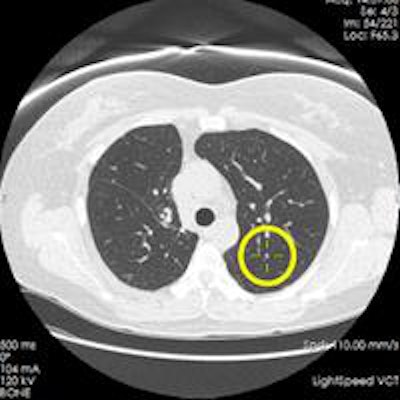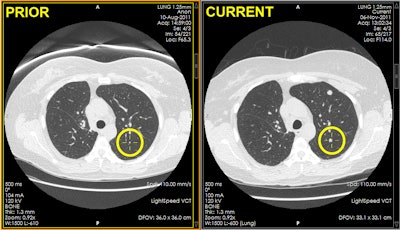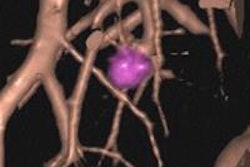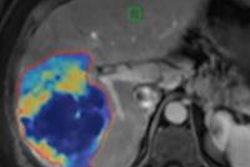
Most PACS vendors don't include automatic deformable image registration algorithms in their workstation software. But they should, as these can sharply reduce the time it takes for radiologists to match lung nodule locations on serial lung CT scans, according to researchers from Stony Brook Medicine.
In a retrospective study, the Stony Brook team found that using a PACS-integrated automatic deformable registration method took approximately half the time to match lung nodule locations than a manual registration technique.
"[The method] saves time, improves efficiency, and, in total, will decrease cost, allowing radiologists to read more of these studies," said Dr. Matthew Barish, who presented the group's findings during a scientific session at the recent Society for Imaging Informatics in Medicine (SIIM) meeting in Long Beach, CA.
A challenging task
Lung nodules are a common finding on chest CT scans, and adoption of CT lung cancer screening will increase both the number of scans and the average number of nodules per scan, Barish said. Serial CT scans are used to assess the growth, stability, or resolution of nodules over time.
At follow-up, radiologists must match nodules between prior exams and the current study. This process is performed by locating the nodule on the prior study, typically by using the prior radiology report as a guide. The radiologist then finds the nodule on the current study or the region where the nodule was located if it has been resolved, he said.
In the absence of registration, nodule localization can take considerable time, effort, and cost, and it can be challenging to locate the same nodule in current and prior studies. Patient positioning can vary, as can the overall degree of breath-holding and the lung, lobe, or segment expansion between the current and prior exams. There may have also been surgical or radiation intervention during the interval, Barish said.
Image registration between current and prior exams reduces the time needed to locate nodules, and rigid registration (i.e., synchronized scrolling) techniques are available on nearly all PACS software, he said. Deformable registration, however, is not currently available on most PACS workstations.
"If it is available, it's only through some external third-party product that one has to enter into outside of the traditional PACS paradigm," Barish said.
The researchers hypothesized that a PACS-integrated automatic deformable registration technique would reduce lung nodule location matching time in serial chest CT, compared with conventional manual slice synchronization in PACS. To test the theory, they performed a retrospective study involving 27 subjects who had been identified with lung nodules on two chest CT studies performed within three years of each other. Any patients with interval surgery or radiation were excluded from the study.
There were 112 total nodules identified on prior studies, and the researchers determined the series and slice number as well as anatomical location for each nodule on the first study, which was considered the "prior" exam. Two board-certified radiologists were then given the nodule location on the prior study and were asked to match each nodule on the prior study to a location on the current exam.
The researchers measured the time it took from when the reviewer identified the nodule in the prior exam to when the nodule or spatial location was found in the second study. In two reading sessions performed three weeks apart to reduce recall bias, the radiologists performed the matching task with one of two methods: manual-rigid registration (MRR) on ClearCanvas PACS software and using an automatic-deformable registration (ADR) plug-in for ClearCanvas from Blackford Analysis.
The MRR process involves manually synching at the most superior slice where air is seen in the right lung, Barish said. Reviewers then have synchronized scrolling in the axial plane; movement to a particular slice in the prior study will cause movement to a slice in the current exam that is the same z-axis distance.
 Appearance of PACS display immediately after clicking the automatic deformable registration tool, demonstrating instant location matching of nodules between current and prior studies. Images courtesy of Dr. Matthew Barish.
Appearance of PACS display immediately after clicking the automatic deformable registration tool, demonstrating instant location matching of nodules between current and prior studies. Images courtesy of Dr. Matthew Barish.Automated deformable registration
No human input is needed for ADR, however. The mutual information-based deformable registration algorithm first derives an approximate rigid registration through a parallelized search of possible rigid transformations starting from multiple randomly seeded starting points.
"This rigid registration obtained was used to initialize a warp field that is iteratively improved by the introduction of local deformations until the evaluation function is maximized," he said.
| Average nodule matching time | ||
| Reviewer No. 1 | Reviewer No. 2 | |
| MRR | 2.98 seconds | 1.84 seconds |
| ADR | 1.24 seconds | 0.97 seconds |
| Reduction in time | 58.2% (± 7.6%) | 47.4% (± 7.7%) |
The readers had a combined average time reduction percentage of 52.8% (± 5.4%) using the ADR algorithm.
The researchers also observed an increase in the number of cases with an instant location match, which was defined as the nodule being confidently matched without the need to scroll through images. The first reviewer had 41 (37%) instant matches with ADR, compared with 17 (15%) using MRR. The second reviewer had 46 instant matches (41%) using ADR, compared with only 14 (13%) with MRR.
Barish said there were a number of study limitations. For example, the time to perform registration was not included in the timings. If this had been included, factors such as a longer setup time for manual registration would have led to even greater time improvements from automated deformable registration.
"PACS vendors and users should investigate incorporating deformable registration into the reading paradigm," he said.




















